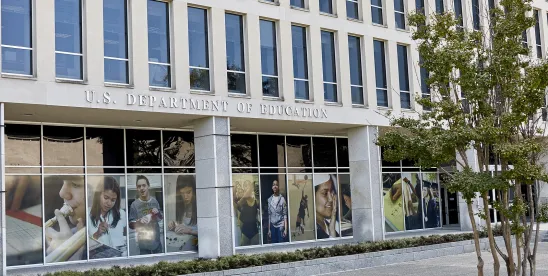On April 19, the U.S. Department of Education (DOE) unveiled its “Final Rule” to update the Title IX regulations governing sex discrimination on campuses nationwide. Schools’ implementation window is short, as the new regulations take effect August 1, 2024.
While the regulations attempt to expand protections in certain directions – including for pregnancy and related conditions and for LGBTQI+ individuals – the rules change more text than substance on the procedures for adjudicating complaints of harassment or assault. For those of us who work on campus, we know many situations do not result in formal complaints and adjudicative processes, but rather require earlier interventions to effectively address reports of sex discrimination.
Schools that implemented the 2020 regulations thoughtfully and filled some of their jurisdictional gaps with intentionality will not find the new call to change disciplinary procedures too onerous.
Broader Definitions for Sex Discrimination and “Sex-Based Harassment” Under Title IX
Sex Discrimination
Under the Final Rule, the definition of sex discrimination has been updated to follow the Supreme Court’s Title VII opinion in Bostock v. Clayton County, 590 U.S. 644, 659–62 (2020), to include sexual orientation and gender identity, as well as pregnancy and pregnancy-related conditions. The Final Rule also prohibits treating students, applicants, or employees differently based upon their parental, family, or marital status.
The Final Rule expresses that preventing a person from participating in an education program or activity consistent with their gender identity constitutes more than a de minimis harm and therefore violates Title IX.
Sex-Based Harassment
“Sex-based harassment” is defined as a form of sex discrimination and includes harassment based upon the broad definition of “sex.” Sex-based harassment retains the three key aspects of “sexual harassment” defined under the 2020 regulations: quid pro quo harassment, hostile environment harassment, and specific offenses (sexual assault, dating violence, domestic violence, and stalking). The definitions of quid pro quo and specific offenses remain essentially unchanged; hostile environment harassment is expanded to be defined as:
- Unwelcome sex-based conduct, based on the totality of the circumstances, that is (1) subjectively and objectively offensive and (2a) so severe or (2b) so pervasive that it limits or denies an individual’s ability to participate in or benefit from an education program or activity.
This change now mirrors the standards under Title VII for hostile environment harassment, which provides that the offensive conduct need only be severe or pervasive. It need not be both.
What’s Changed
- The adoption of the broad definition of “sex,” aligning in part with Supreme Court precedent under Title VII and other cases on sexual identity.
- A lower threshold of harm to establish sex discrimination. The Final Rule specifically states that “[a]dopting a policy or engaging in a practice that prevents a person from participating in an education program or activity consistent with the person’s gender identity subjects a person to more than de minimis harm on the basis of sex.” Section 106.31(a)(2) (subject to housing and athletics exceptions).
- A modified standard for hostile environment harassment. Unwelcome sex-based conduct constitutes hostile environment harassment if “based on the totality of the circumstances, [the conduct] is subjectively and objectively offensive and is so severe or pervasive that it limits or denies a person’s ability to participate in or benefit from the … education program or activity.” Section 106.2 (sex-based harassment definition, at (2)).
- Affirmative accommodations are required for students, applicants, and employees for pregnancy, pregnancy-related conditions, and lactation. In many cases, requiring documentation to support such accommodations is prohibited.
Potential Pitfalls and Considerations
- Schools will need to update policies to incorporate the broader scope of sex discrimination and sex-based harassment, explicitly addressing discrimination and harassment based on LGBTQI+ status. That said, we will also be watching the courts, as litigation has already been threatened to enjoin this portion of the Final Rule.
- Religious institutions should evaluate whether and how religious exemptions should or could apply.
- Schools should understand and train employees to recognize the low threshold for establishing sex-based discrimination.
- Schools should understand that the standard for establishing hostile environment harassment will now more closely match the standard set under Title VII for a hostile work environment.
- Additional policies may be required to address parental, family, marital status, and pregnancy discrimination and accommodations. Notably, accommodations for pregnancy and lactation largely mirror the recently enacted Pregnant Workers Fairness Act regulations, and institutions may wish to coordinate those policies. In the meantime, they should also be aware that 17 state attorneys general have already sued to halt those regulations.
- Schools should update and conduct training on the expanded definitions, including particular examples of the implications of the broadened scope of “sex” under the regulations.
- Watch for additional DOE guidance on gender identity and single-sex athletics.
Title IX Rules Extend Off-Campus
- The Title IX regulations apply to “all sex discrimination occurring under a [school’s] education program or activity,” which now includes “conduct that occurs in a building owned or controlled by a student organization that is officially recognized by a postsecondary institution, and conduct that is subject to the [school’s] disciplinary authority.” Section 106.11.
- Schools must address a sex-based hostile environment under their education programs or activities, even if some of the conduct that allegedly contributed to the hostile environment “occurred outside the [school’s] education program or activity or outside the United States.” Id.
What’s Changed
- While the 2020 regulations were relatively narrow in their jurisdictional reach, off-campus behavior now may be subject to the Final Rule if it contributes to a sex-based hostile environment occurring under the school’s education program or activity.
Potential Pitfalls and Considerations
- Schools should update their policies and procedures to address incidents of sex discrimination and harassment that occur off-campus, including out-of-state or outside of the United States (study abroad), when those incidents create a sex-based hostile environment within the school’s education program or activity.
- Schools should update their policies and procedures to account for the expanded jurisdiction into sexual misconduct that may occur at fraternities and sororities, social clubs, and other off-campus buildings owned or rented by officially recognized student organizations.
Employee Reporting Requirements Are Expanded; Training Becomes Even More Critical
The Final Rule specifies the duties of all school employees to report potential sex discrimination.
Schools can be liable under Title IX if they do not properly act despite having “actual knowledge” of incidents that would violate Title IX. Actual knowledge is defined to include knowledge by those within the university community who have authority to institute corrective measures on behalf of the school. Gebser v. Laga Vista Ind. Sch. Dist., 524 U.S. 274, 290 (1998). In short, employees now have duties to convey their personal knowledge to the Title IX Coordinator (who has authority to institute corrective measures) and/or to potential complainants.
The mandatory reporting requirements differ slightly based on broad employee categories.
What’s Changed
The 2020 regulations limited mandatory reporting requirements, but the new regulations expand their scope. Under the new Section 106.44(c)(2):
- Universities “must, at a minimum require” all employees who have “authority to institute corrective measures on behalf of the [school] or [who have] responsibility for administrative leadership, teaching or advising” functions within the school “to notify the Title IX Coordinator when the employee has information about conduct that reasonably may constitute sex discrimination.”
- Employees who do not have such “authority” or “responsibility” may either “notify the Title IX Coordinator when the employee has information about conduct that reasonably may constitute sex discrimination,” or instead “[p]rovide the contact information of the Title IX Coordinator and information about how to make a complaint” to any person who provides the employee with information about such conduct. Id. Schools “have discretion to determine which of these two actions [such] employees must take or whether to leave the [choice of option] to those employees.” Preamble, at pages 366-367.
- Confidential employees and student employees are exceptions to the mandatory reporting requirements.
Potential Pitfalls and Considerations
Once a school’s Title IX Coordinator receives notice of an allegation – which is likely to happen more frequently under the new regulations’ reporting requirements – the school is deemed to have actual knowledge and potential liability if it fails to adequately act.
One potential pitfall of these reporting requirements is that they may supersede the complainant’s privacy interests. When crafting these changes, the DOE acknowledged that “[s]ome commenters argued that mandatory reporting violates the autonomy of complainants and their ability to request confidentiality and decide when to initiate grievance procedures.” Preamble, at page 354. However, the DOE decided that the mandatory notification requirements contained in Section 106.44(c) were more important to “help ensure that a [school] learns of sex discrimination in its education program or activity so it can be addressed,” Preamble, at page 341, including through the provision of supportive measures even when no complaint is initiated. In addition, the Final Rule augments institutions’ obligation to prevent retaliation, Section 106.71, which mitigates some of the privacy concerns.
All employees are subject to annual Title IX training requirements, Section 106.8(d), and thus it is critical for those employees to receive sufficient training about their reporting obligations. Adequate training of all categories of employees will help schools avoid liability for failing to address reported allegations of sex discrimination by students or employees.
New Rules for Title IX Grievance Procedures That Could Lead To Disciplinary Measures
As noted earlier, most of the Final Rules’ content concerns regulations for grievance procedures to respond to discipline-seeking complaints, even if most incidents may not follow that route.
As an alternative to the prior mandates to investigate and adjudicate discipline-seeking complaints of sex discrimination, the Final Rule modifies those procedures to provide options for institutions in particular cases. The 2020 regulations contained detailed grievance procedures, including live hearings, and prohibitions against the “single investigator model” to adjudicate such complaints. While those two processes are still considered “best practices” to adjudicate complaints of sex-based harassment that could result in expulsion, the Final Rule allows institutions to modify those processes.
What’s Changed
- The Final Rule eliminates the requirement that different individuals serve in the separate roles of Title IX Coordinator, investigator, and decision-maker in each case. The DOE will now permit a “single investigator model,” which combined with the Rule’s requirements for training and a commitment to an unbiased process, may provide a fair and equitable process for resolving complaints.
- The Final Rule specifies that the school’s complaint adjudication process “must provide a process that enables the decision-maker to question parties and witnesses to adequately assess a party’s or witness’s credibility to the extent credibility is both in dispute and relevant to evaluating one or more allegations of sex discrimination.” That said, a hearing is no longer required. Section 106.45(g); see also Section 106.46(f).
- Moreover, such questioning will now typically be performed by the decision-maker, rather than a cross-examination by the opposite party’s advisor – which is a change that many schools had already worked into their hearing processes in modified forms. The Final Rule now requires separate grievance procedures for complaints of sex discrimination, Section 106.45, and complaints of sex-based harassment involving a student complainant or a student respondent. Section 106.46. While the former section does not specify a process for the parties to participate in questioning during the adjudicative phase, Section 106.46(f) provides that parties will now typically participate by submitting their questions to the decision-maker, to be asked in a neutral, albeit dutiful, voice.
- The Final Rule broadens the circumstances for consolidation of complaints, including complaints against more than one respondent, or by the respondent against the complainant, or when the allegations involving different parties arise from the same facts or circumstances.
- Finally, the Final Rule allows schools to create reasonable timeframes for the grievance procedures and allows extensions on a case-by-case basis. By contrast, the prior regulations limited extensions to those based on “good cause” and required timeframes only in connection with the conclusion of the grievance process.
Potential Pitfalls and Considerations
Institutions should evaluate their newfound discretion cautiously. Schools that implemented the 2020 regulations thoughtfully to avoid some of their rough edges may largely choose to stick with their existing ideals. Litigation remains around the corner of every emotionally charged Title IX proceeding, and significantly loosening due process protections may not always be in the best interests of the schools or their students.
Implementing the New Regulations Into University Policies – What Should Schools Do?
Institutions must examine existing policies for compliance with the Final Rule. In particular, each institution should review policies that deal with the grievance-and-resolution procedures for reports of sex-based harassment and misconduct.
When evaluating the scope of the new Rule, and the quantity of changes to the grievance procedures (specifically, 34 C.F.R. Sections 106.45 and .46), the policy-update process may seem overly complicated. However, we suspect it will not be too onerous for schools who have been investing in student-focused processes over the last four years.
What’s Changed
The Final Rule adds more color to the grievance “basics” in Section 106.8, while substantially reorganizing the detailed grievance procedures once housed only in Section 106.45.
More specifically, the Final Rule divides the grievance procedures; that is, the Rule creates the following: (1) a less detailed Section 106.45, which applies broadly to complaints of on-campus discrimination that involves anyone on campus (student, employee, or third party) and (2) a detailed Section 106.46, which carries over and adjusts many of the rigorous procedures from the 2020 version of Section 106.45, but which applies on- or off-campus, only to “sex-based harassment” (including assault), and only where the complaint involves a student party.
In other words, all complaints of sex discrimination trigger the new Section 106.45; but if the complaint also involves harassment and at least one student, the more rigorous provisions of Section 106.46 apply as well.
Substantively, the new procedures detail how complaints of broader conduct (described above) should be resolved, and they adjust the procedure for more serious conduct involving students.
Potential Pitfalls and Considerations
Institutions must now confront the choice of how – and how much – to revise their policies to fit the new rules. Certainly, they may start from scratch. But they should think twice before doing so, and might consider a limited approach, for several reasons:
- Changing policies in any area of campus function is always hard, and arguably most difficult when it comes to such complex and high-stakes issues as Title IX harassment grievances. To the extent a school can achieve compliance with few adjustments, it should consider the pains of overhaul and the benefits of continuity.
- Many schools already have policies in place that are more robust than the prior or current regulations in key areas. It is possible that an institution’s policies are already (mostly) compliant, even in areas that have changed.
- Many schools already have a two-track system for reports of sex-based discrimination and harassment: one track for reports within the scope of the 2020 regulations, and another track for those beyond it. Institutions can certainly keep that that two-track system in place. Nevertheless, institutions should consider examining the “second track” to see which circumstances may have now changed, from beyond the regulatory scope to within it (e.g., for instances of non-harassment discrimination, or off-campus harassment involving a student).
In sum, while every school will need to revisit and revise its grievance-procedure policies, it should consider whether it can do so with a scalpel, instead of a hatchet.
What’s Next?
Stepping back from the detailed provisions of the new regulations, two things are clear:
First, most instances of sex discrimination will likely not result in a discipline-seeking complaint. Nonetheless, schools retain an obligation under Title IX to prevent sex discrimination and address it when it occurs. Schools retain significant discretion in this area outside of the regulations, and they potentially face liability if they fail to properly act.
Second, and notwithstanding all of the above, a school “may not impose discipline on a respondent for sex discrimination prohibited by Title IX unless there is a determination at the conclusion of the [school’s] grievance procedures that the respondent engaged in prohibited sex discrimination.” Section 106.45(h)(3). Thus, without a complaint and the fulfillment of all necessary grievance procedures, the Final Rule’s expanded scope can only be addressed through supportive measures and informal resolutions.
In other words, implementation of the regulations’ terms will not insulate schools from all potential Title IX liability – but thoughtful policies and procedures will provide additional protection for schools and their constituents.








 />i
/>i

